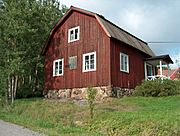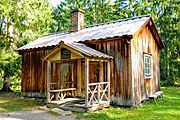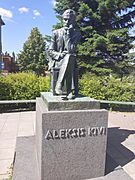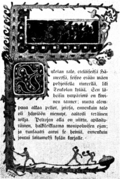Aleksis Kivi facts for kids
Quick facts for kids
Aleksis Kivi
|
|
|---|---|
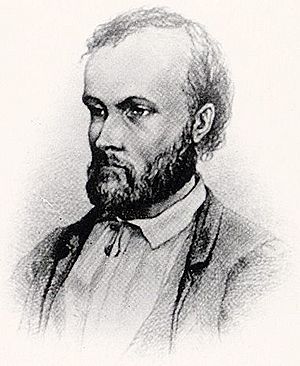
Earliest known image of Kivi, almost certainly by Albert Edelfelt (1873)
|
|
| Born |
Alexis Stenvall
10 October 1834 Palojoki, Nurmijärvi, Grand Duchy of Finland
|
| Died | 31 December 1872 (aged 38) |
|
Notable work
|
Seitsemän veljestä ("Seven Brothers") |
Aleksis Kivi (Finnish pronunciation: [ˈɑleksis ˈkiʋi]; born Alexis Stenvall; 10 October 1834 – 31 December 1872) was a famous Finnish author. He wrote the very first important novel in the Finnish language. This book was called Seitsemän veljestä ("Seven Brothers") and came out in 1870.
Kivi is also well-known for his play Heath Cobblers from 1864. Even though he was one of the first writers to create stories and poems in Finnish, many people still think he is one of the greatest. Finland celebrates his birthday, October 10, as Finnish Literature Day. He is seen as a national writer.
Contents
Life of Aleksis Kivi
Aleksis Stenvall was born in the village of Palojoki in Nurmijärvi, which was then part of the Grand Duchy of Finland. His father, Erik Johan Stenvall, was a village tailor. His mother was Anna-Kristiina Hamberg. Aleksis had three older brothers: Johannes, Emanuel, and Albert. He also had a sister named Agnes, who sadly passed away at age 13.
Early Life and Education
In 1846, Aleksis moved to Helsinki to go to school. Later, in 1859, he was accepted into the University of Helsinki. There, he studied literature and became very interested in theatre. His first play was Kullervo. It was based on a sad story from the Finnish national epic, the Kalevala. During this time, he also met Johan Vilhelm Snellman, a famous journalist who supported his work.
While studying, Kivi read many books from around the world. He also watched plays by famous writers like Molière and Schiller at the Swedish Theatre in Helsinki. He had good friends too, such as Fredrik Cygnaeus and Elias Lönnrot.
Becoming a Writer
From 1863 onwards, Kivi spent all his time writing. He wrote 12 plays and a collection of poems. His most famous novel, Seitsemän veljestä ("Seven Brothers"), took him ten years to complete.
When Seitsemän veljestä was published, some literary critics did not like it. A well-known critic named August Ahlqvist thought the book was "ridiculous." He felt it was a "blot on the name of Finnish literature." At that time, many people preferred stories that were more romantic and idealized. Some groups also disliked how Kivi showed rural life, as it was different from their perfect ideas.
In 1865, Kivi won a State Prize for his comedy Nummisuutarit. This play, also known as The Cobblers on the Heath, is still performed often today. His main helper, Charlotta Lönnqvist, supported him during his writing years.
Later Years
By 1870, Kivi's health became very poor. He became ill and was admitted to a hospital. Later, he was moved to a special hospital in Lapinlahti. Aleksis Kivi passed away in 1872 at the age of 38. He died at his brother Albert's home in Tuusula, near Lake Tuusula. Legend says his last words were, "I live" (Finnish: "Minä elän").
Aleksis Kivi's Legacy
In the early 1900s, young writers like Volter Kilpi and Eino Leino helped make Kivi a national hero. Many writers after him, such as Väinö Linna and Veijo Meri, felt a connection to Kivi's journey as an author.
Honors and Memorials
- In 1936, the Aleksis Kivi Prize was created. This award celebrates important contributions to Finnish literature.
- In 1939, a bronze statue of Kivi was placed in front of the Finnish National Theatre. This statue was made by Wäinö Aaltonen.
- Many streets in Finnish cities are named after Kivi, like Aleksis Kiven katu in Tampere.
Kivi in Arts
- From 1995 to 1996, Finnish composer Einojuhani Rautavaara wrote an opera about Kivi's life and works.
- There are two films about Aleksis Kivi:
- "I Live" (Finnish title: "Minä elän") from 1946, directed by Ilmari Unho.
- The Life of Aleksis Kivi (Finnish title: Aleksis Kiven elämä) from 2002, written and directed by Jari Halonen.
Gallery
-
1934 postage stamp commemorating Kivi, by Germund Paaer, after a sculpture by Wäinö Aaltonen
Kivi in English
- Impola, Richard A., trans. Aleksis Kivi, Seven Brothers (English translation of Seitsemän veljestä). New Paltz, NY: Finnish-American Translators Association, 1991.
- Matson, Alex, trans. Aleksis Kivi, Seven Brothers (English translation of Seitsemän veljestä). 1st edition, New York: Coward-McCann, 1929. 2nd edition, Helsinki: Tammi, 1952. 3rd edition, edited by Irma Rantavaara, Helsinki: Tammi, 1973.
- Robinson, Douglas, trans. Aleksis Kivi's Heath Cobblers and Kullervo. St. Cloud, MN: North Star Press of St. Cloud, 1993.
- Robinson, Douglas, trans. The Brothers Seven. Bucharest, Romania: Zeta Books, 2017
Secondary sources
- Robinson, Douglas, Aleksis Kivi and/as World Literature. Leiden and Boston: Brill, 2017.
- Tarkiainen, Viljo, Aleksis Kivi: elämä ja teokset. WSOY, 1950.
See also
 In Spanish: Aleksis Kivi para niños
In Spanish: Aleksis Kivi para niños


